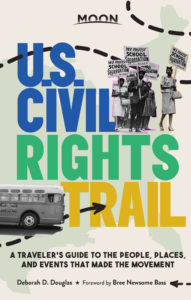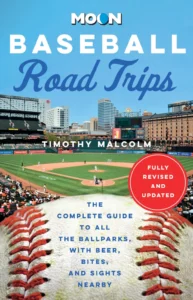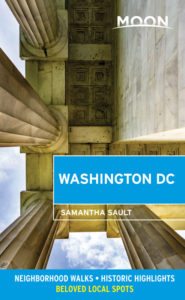Washington, D.C.
US-50 Across Washington DC
Following US-50 across Washington DC takes you through the heart of the nation’s capital. Starting in the west, alongside Arlington National Cemetery at the Iwo Jima Memorial (which sits in the middle of a traffic circle and is all but impossible to reach), US-50 crosses the Potomac River, entering “The District” on the Theodore Roosevelt Bridge—making a beeline toward the State Department. US-50 then follows Constitution Avenue along the north side of The Mall, running past the Lincoln and Vietnam Veterans Memorials and between the White House and the Washington Monument, before zigzagging northeast along 7th Street and New York Avenue. Heading east of DC, US-50 turns into a freeway and runs east to Annapolis and the Chesapeake Bay.
Exploring Washington DC
Even if you slept through high school history and have zero interest in politics, visiting Washington DC (pop. 702,455), is an unforgettable experience. The monuments that line the city’s many grand avenues embody nearly two centuries of American political history, and museums show off everything from ancient art to the first flying machines. Best of all, almost everything is free, though there are caveats every visitor should know. Parts of DC can be dangerous after dark and the weather varies tremendously, from freezing cold in winter to swelteringly hot and humid in summer (though both spring and fall can be lovely).
You’ll probably spend the bulk of your time at the many fine art and history museums that line the National Mall, at the center of town, all run by the Smithsonian Institution (daily, free, 202/633-1000). The huge and endearingly quirky National Museum of American History (202/633-1000, daily, free), on the north side of the Mall between 12th and 14th Streets, is sometimes called the “Nation’s Attic,” displaying a little of everything: the giant flag that inspired Francis Scott Key to write the “Star-Spangled Banner”; a pair of ruby slippers Judy Garland wore in The Wizard of Oz; even a 40-foot stretch of historic Route 66, part of the massive “America on the Move” transportation exhibit.
In recent years, a trio of impressive museums and monuments have opened along the National Mall. Closest to the Capitol is the National Museum of the American Indian. At the west end of the Mall is the Franklin Delano Roosevelt Memorial, which traces the journey of our longest-serving U.S. president from his elite childhood, through his midlife affliction by polio, up through the Great Depression, the New Deal, and World War II. The newest museum is the intensely moving National Museum of African American History and Culture between the Washington Monument and the White House.
Your favorite memory of visiting Washington may be watching workers pushing wheelbarrows full of money across the floors of the Bureau of Engraving and Printing (301 14th St. SW, 202/874-2330, Mon.-Fri., free, tickets required in peak season), south of the United States Holocaust Memorial Museum. This high-security printing plant is where your hard-earned cash—some $300 billion a year—is born, along with postage stamps.
Washington’s baseball team, the Nationals (888/632-6287), play at the $611-million stadium on the Anacostia River, near the Navy Yard metro station.
Navigating Washington DC
Ronald Reagan Washington National Airport (DCA) is DC’s main airport, near downtown and easily accessible on the Metro subway system. The second DC airport is Dulles International Airport (IAD), way out in the western suburbs, which handles most international flights (and has a large branch of the Smithsonian Air and Space Museum nearby). By road, DC lies on the busy north-south I-95 corridor, encircled by the I-495 Beltway. US-50, redubbed I-595 east of DC and supplemented in the west by the I-66 freeway, is the main east-west artery.
The basic layout of DC is fairly simple, as the entire diamond-shaped city is divided into four quadrants (NE, NW, SE, and SW) with the Capitol at the center. However, because of DC’s baroque street plan, with its extensive one-way systems, driving can be confusing. Avail yourself of the handy Metro subway, which serves most of the places you’ll want to go. It may also help to know that the Mall, where most of the museums and memorials are located, is roughly 2 mi (3.2 km) long, from the Capitol west to the Potomac River.
Where to Stay and Eat in Washington DC
The cheapest and most convenient place to sleep is the modern HI Washington DC Hostel (1009 11th St. NW, 202/737-2333, dorm around $38-50, private rooms $90-140), within walking distance of the White House. It has amenities like Wi-Fi and air-conditioning (essential in a DC summer). At the plushest end of the price and comfort spectrum, The Hay-Adams hotel (800 16 St. NW, 202/638-6600, $348 and up), directly across from the White House, is luxurious and old-fashioned, with a grand lobby and discreet Off the Record cocktail bar full of expense-account lobbyists. The nicest midrange place to stay is the Woodley Park Guest House (2647 Woodley Rd. NW, 202/667-0218, $175 and up), which has clean, nicely furnished rooms and helpful staff in a convenient location near the Zoo Metro stop and trendy Adams-Morgan neighborhood.
To wine and dine with the movers, shakers, and wannabes, head to Wisconsin Avenue in Georgetown, at the northwest edge of the district, or leap back to a time when polished wood bars and brass spittoons were the order of the day at the Old Ebbitt Grill (675 15th St. NW, 202/347-4800), east of the White House. Open early until late, this casual grill serves everything from breakfasts and burgers to oysters and filet mignon. Along the canal, Georgetown’s Pizzeria Paradiso (3282 M St. NW, 202/337-1245) has wood-fired pies and a fine range of beers (there’s a bigger branch in Dupont Circle as well). For a more down-home taste, head north on the Green Line Metro to the U Street station, near which you can enjoy chili dogs at Ben’s Chili Bowl (1213 U St. NW, 202/667-0909); Ben’s also has a stand at the Nationals ballpark.
















